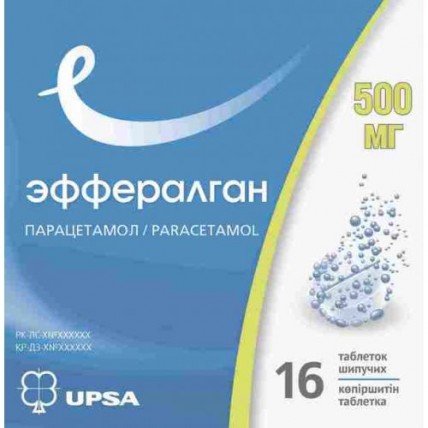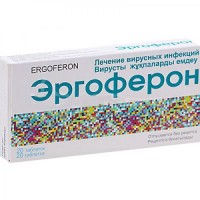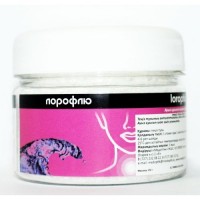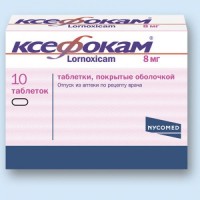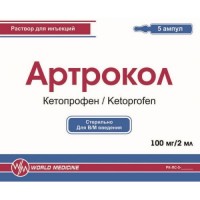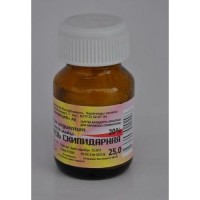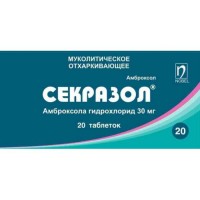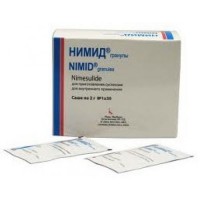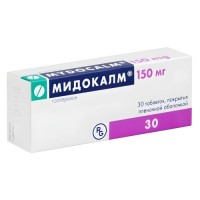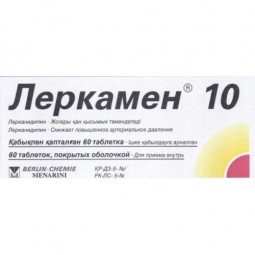Efferalgan 16's 500 mg effervescent tablets
- $9.60
The instruction for medical use
of EFFERALGAN medicine
the Trade name
Efferalgan
Mezhdunarodnoye the unlicensed
name Paracetamol Dosage Form
of the Tablet sparkling 500 mg
Structure
One tablet contains
active agent: paracetamol of 500 mg,
excipients: anhydrous citric acid, sodium hydro-carbonate, sodium carbonate anhydrous, E 420 sorbite, sodium docusate, povidone, saccharin of E 954 sodium, Natrium benzoicum.
The description
of the Tablet of white color with slanted edges and risky, soluble in water. At dissolution in water discharge of vials of gas is observed.
Pharmacotherapeutic group
Analgetics and antipyretics. Anilides. Paracetamol.
The ATX N02BE01 code
the Pharmacological
Pharmacokinetics At properties oral administration of paracetamol absorption happens quickly and completely. The maximum concentration in plasma are reached in 30-60 minutes after reception. Paracetamol is quickly and evenly distributed in all fabrics. Linking with proteins of plasma weak. Paracetamol is metabolized mainly in a liver. Drug is removed mainly with urine. 90% of the accepted dose are removed by kidneys within 24 hours, generally in the form of glucuronic conjugates (60-80%) and sulphatic conjugates (20-30%). Less than 5% are removed in not changed look. Elimination half-life makes about 2 hours.
Renal failure: in case of a heavy renal failure (clearance of creatinine less than 10 ml/min.) removal of paracetamol and its metabolites slows down.
At elderly people the ability to conjugation does not change.
The pharmacodynamics
Analgetic effect of sparkling tablets occurs quicker, than at reception of the usual tablets containing paracetamol. Efferalgan (paracetamol), possesses soothing and febrifugal action that is connected with its influence on the center of thermal control in a hypothalamus and ability to inhibit synthesis of prostaglandins, eliminates a headache and other types of pain, reduces the increased temperature.
Indications
Pain syndrome of weak or moderate intensity, including: head and a toothache, pains in sciatica, muscular and rheumatic pains, neuralgia, algodismenoreya, pain in injuries and burns, a sore throat in catarrhal diseases.
Catarrhal (acute respiratory diseases, flu), and other infectious diseases which are followed by fervescence.
A route of administration and doses
Completely to dissolve a tablet in a glass of water and to drink.
This form of release is intended for adults and children with body weight more than 50 kg (15 years and are more senior).
The recommended daily dose of paracetamol makes 60 mg/kg/day. The daily dose should be divided into 4 or 6 receptions, i.e. to about 15 mg/kg there are each 6 hours or to 10 mg/kg there are each 4 hours.
The maximum single dose makes 2 tablets on 500 mg. Maximum daily 8 tablets. Always it is necessary to observe an interval of 4 hours between receptions.
In case of a heavy renal failure the interval between receptions has to make not less than 8 hours and the daily dose should not exceed 3 g of paracetamol a day.
Treatment duration without medical observation should not exceed 3 days, when assigning as febrifuge and 5 days as sedative.
Side effects
- nausea, vomiting, an abdominal pain,
- skin rash, a small tortoiseshell, a Quincke's disease, a Quincke's edema, a Lyell's disease, Stephenson-Johnson's syndrome.
At prolonged use:
- anemia, agranulocytosis, thrombocytopenia, leukopenia, hemolytic and aplastic anemia.
At prolonged use in high doses:
- a methemoglobinemia,
- a pancytopenia.
Seldom:
- an acute anaphylaxis,
- an abnormal liver function,
- interstentsialny nephrite, a renal failure, an oligouriya, an anury.
Contraindications
- hypersensitivity to paracetamol and other components of drug,
- hepatocellular insufficiency,
- blood diseases, including anemia,
- deficiency of enzyme of glyukozo-6-phosphate-dehydrogenase,
- pregnancy, the lactation period,
- an alcoholism,
- children's age up to 15 years.
Medicinal interactions
are Reduced by efficiency of uricosuric drugs. The accompanying use of paracetamol in high doses increases effect of anticoagulating means (decrease in synthesis of procoagulant factors in a liver). Inductors of microsomal oxidation in a liver (Phenytoinum, ethanol, barbiturates, rifampicin, phenylbutazone, tricyclic antidepressants), ethanol and gepatotoksichny drugs increase products of hydroxylated active metabolites that causes a possibility of development of heavy intoxications even at small overdose. Long use of barbiturates reduces efficiency of paracetamol. Ethanol contributes to the development of acute pancreatitis. Inhibitors of microsomal oxidation (including Cimetidinum) reduce risk of hepatotoxic action. Long sharing of paracetamol and other nonsteroid anti-inflammatory drugs increases risk of development of an analgetic nephropathy and renal capillary necrosis, approach of an end-stage of a renal failure. Simultaneous long prescribing of paracetamol in high doses and salicylates increases risk of developing cancer of kidneys or a bladder. Diflunisal increases concentration in paracetamol blood plasma by 50% - risk of development of hepatotoxicity.
Special instructions
At the proceeding feverish syndrome against the background of paracetamol use more than 3 days, and a pain syndrome - more than 5 days, consultation of the doctor is required.
Risk of development of injuries of a liver increases at patients with an alcoholic hepatosis. Distorts indicators of laboratory researches at quantitative determination of content of glucose and uric acid in plasma.
During long-term treatment the control of a picture of peripheral blood and a functional condition of a liver is necessary.
This drug contains 412.4 mg of sodium on one tablet that has to be considered by people, being on a rigid low-salt diet. As drug contains sorbitol, it should not be applied at intolerance of fructose, bad adsorption of glucose and a galactose, deficiency of isomaltose.
With care appoint to patients at Gilbert's syndrome, with a benign hyperbilirubinemia and also to patients of advanced age. Paracetamol is a methemoglobin former. At emergence of side effects it is necessary to stop administration of drugs.
Features of influence of drug on ability to run motor transport and dangerous mechanisms
Considering side effects of medicine, it is necessary to be careful at control of motor transport or potentially dangerous mechanisms.
Overdose
Symptoms: nausea, vomiting, anorexia, pallor, an abdominal pain usually develop within the first 24 hours.
The overdose over 10 g of paracetamol at one time in adults and 150 mg/kg of weight at one time in children can cause a cytolysis of hepatocytes which can lead to full and irreversible necrosis, with the subsequent development of a liver failure, metabolic acidosis, encephalopathies which can lead to a coma or death.
At the same time increase in level of hepatic transaminases, lactate dehydrogenases, bilirubin and the reduced level of a prothrombin within 12-48 hours after overdose is observed.
Treatment: gastric lavage, intake of activated carbon, calling of vomiting, introduction of donators of SH-group and predecessors of synthesis of glutathione of methionine in 8 9 h after overdose and N-Acetylcysteinum in 12 hours.
The form of release and packing
4 tablets are placed in planimetric bezjyacheykovy packing (strip) from aluminum foil with a polyethylene covering.
On 4 planimetric bezjyacheykovy packs (strips) together with the instruction for medical use in the Kazakh and Russian languages place in a cardboard box.
To Store storage conditions in the dry place at
a temperature not higher than 30 S. Hranit out of children's reach!
3 years
not to use a period of storage after an expiration date.
Prescription status
Without prescription
UPSA SAS Producer,
979 avenues of de Pirene, 47520 Le the Passage, France.
Owner of the registration certificate
of UPSA SAS,
3 Rue Joseph Monie, 92500 Ryuey-Malmezon, France.
The name and the address of the organization in the territory of the Republic of Kazakhstan, the accepting claim (offer) on quality of medicine from consumers, responsible for post-registration observation of safety of medicine
of Predstavitelstvo joint-stock company Delta Medikel Promoushnz AG
(Switzerland), 050040, Almaty, Bostandyksky district, Bayzakov St., 280
to Develop
of EFFERALGAN medicine
the Trade name
Efferalgan
Mezhdunarodnoye the unlicensed
name Paracetamol Dosage Form
of the Tablet sparkling 500 mg
Structure
One tablet contains
active agent: paracetamol of 500 mg,
excipients: anhydrous citric acid, sodium hydro-carbonate, sodium carbonate anhydrous, E 420 sorbite, sodium docusate, povidone, saccharin of E 954 sodium, Natrium benzoicum.
The description
of the Tablet of white color with slanted edges and risky, soluble in water. At dissolution in water discharge of vials of gas is observed.
Pharmacotherapeutic group
Analgetics and antipyretics. Anilides. Paracetamol.
The ATX N02BE01 code
the Pharmacological
Pharmacokinetics At properties oral administration of paracetamol absorption happens quickly and completely. The maximum concentration in plasma are reached in 30-60 minutes after reception. Paracetamol is quickly and evenly distributed in all fabrics. Linking with proteins of plasma weak. Paracetamol is metabolized mainly in a liver. Drug is removed mainly with urine. 90% of the accepted dose are removed by kidneys within 24 hours, generally in the form of glucuronic conjugates (60-80%) and sulphatic conjugates (20-30%). Less than 5% are removed in not changed look. Elimination half-life makes about 2 hours.
Renal failure: in case of a heavy renal failure (clearance of creatinine less than 10 ml/min.) removal of paracetamol and its metabolites slows down.
At elderly people the ability to conjugation does not change.
The pharmacodynamics
Analgetic effect of sparkling tablets occurs quicker, than at reception of the usual tablets containing paracetamol. Efferalgan (paracetamol), possesses soothing and febrifugal action that is connected with its influence on the center of thermal control in a hypothalamus and ability to inhibit synthesis of prostaglandins, eliminates a headache and other types of pain, reduces the increased temperature.
Indications
Pain syndrome of weak or moderate intensity, including: head and a toothache, pains in sciatica, muscular and rheumatic pains, neuralgia, algodismenoreya, pain in injuries and burns, a sore throat in catarrhal diseases.
Catarrhal (acute respiratory diseases, flu), and other infectious diseases which are followed by fervescence.
A route of administration and doses
Completely to dissolve a tablet in a glass of water and to drink.
This form of release is intended for adults and children with body weight more than 50 kg (15 years and are more senior).
The recommended daily dose of paracetamol makes 60 mg/kg/day. The daily dose should be divided into 4 or 6 receptions, i.e. to about 15 mg/kg there are each 6 hours or to 10 mg/kg there are each 4 hours.
The maximum single dose makes 2 tablets on 500 mg. Maximum daily 8 tablets. Always it is necessary to observe an interval of 4 hours between receptions.
In case of a heavy renal failure the interval between receptions has to make not less than 8 hours and the daily dose should not exceed 3 g of paracetamol a day.
Treatment duration without medical observation should not exceed 3 days, when assigning as febrifuge and 5 days as sedative.
Side effects
- nausea, vomiting, an abdominal pain,
- skin rash, a small tortoiseshell, a Quincke's disease, a Quincke's edema, a Lyell's disease, Stephenson-Johnson's syndrome.
At prolonged use:
- anemia, agranulocytosis, thrombocytopenia, leukopenia, hemolytic and aplastic anemia.
At prolonged use in high doses:
- a methemoglobinemia,
- a pancytopenia.
Seldom:
- an acute anaphylaxis,
- an abnormal liver function,
- interstentsialny nephrite, a renal failure, an oligouriya, an anury.
Contraindications
- hypersensitivity to paracetamol and other components of drug,
- hepatocellular insufficiency,
- blood diseases, including anemia,
- deficiency of enzyme of glyukozo-6-phosphate-dehydrogenase,
- pregnancy, the lactation period,
- an alcoholism,
- children's age up to 15 years.
Medicinal interactions
are Reduced by efficiency of uricosuric drugs. The accompanying use of paracetamol in high doses increases effect of anticoagulating means (decrease in synthesis of procoagulant factors in a liver). Inductors of microsomal oxidation in a liver (Phenytoinum, ethanol, barbiturates, rifampicin, phenylbutazone, tricyclic antidepressants), ethanol and gepatotoksichny drugs increase products of hydroxylated active metabolites that causes a possibility of development of heavy intoxications even at small overdose. Long use of barbiturates reduces efficiency of paracetamol. Ethanol contributes to the development of acute pancreatitis. Inhibitors of microsomal oxidation (including Cimetidinum) reduce risk of hepatotoxic action. Long sharing of paracetamol and other nonsteroid anti-inflammatory drugs increases risk of development of an analgetic nephropathy and renal capillary necrosis, approach of an end-stage of a renal failure. Simultaneous long prescribing of paracetamol in high doses and salicylates increases risk of developing cancer of kidneys or a bladder. Diflunisal increases concentration in paracetamol blood plasma by 50% - risk of development of hepatotoxicity.
Special instructions
At the proceeding feverish syndrome against the background of paracetamol use more than 3 days, and a pain syndrome - more than 5 days, consultation of the doctor is required.
Risk of development of injuries of a liver increases at patients with an alcoholic hepatosis. Distorts indicators of laboratory researches at quantitative determination of content of glucose and uric acid in plasma.
During long-term treatment the control of a picture of peripheral blood and a functional condition of a liver is necessary.
This drug contains 412.4 mg of sodium on one tablet that has to be considered by people, being on a rigid low-salt diet. As drug contains sorbitol, it should not be applied at intolerance of fructose, bad adsorption of glucose and a galactose, deficiency of isomaltose.
With care appoint to patients at Gilbert's syndrome, with a benign hyperbilirubinemia and also to patients of advanced age. Paracetamol is a methemoglobin former. At emergence of side effects it is necessary to stop administration of drugs.
Features of influence of drug on ability to run motor transport and dangerous mechanisms
Considering side effects of medicine, it is necessary to be careful at control of motor transport or potentially dangerous mechanisms.
Overdose
Symptoms: nausea, vomiting, anorexia, pallor, an abdominal pain usually develop within the first 24 hours.
The overdose over 10 g of paracetamol at one time in adults and 150 mg/kg of weight at one time in children can cause a cytolysis of hepatocytes which can lead to full and irreversible necrosis, with the subsequent development of a liver failure, metabolic acidosis, encephalopathies which can lead to a coma or death.
At the same time increase in level of hepatic transaminases, lactate dehydrogenases, bilirubin and the reduced level of a prothrombin within 12-48 hours after overdose is observed.
Treatment: gastric lavage, intake of activated carbon, calling of vomiting, introduction of donators of SH-group and predecessors of synthesis of glutathione of methionine in 8 9 h after overdose and N-Acetylcysteinum in 12 hours.
The form of release and packing
4 tablets are placed in planimetric bezjyacheykovy packing (strip) from aluminum foil with a polyethylene covering.
On 4 planimetric bezjyacheykovy packs (strips) together with the instruction for medical use in the Kazakh and Russian languages place in a cardboard box.
To Store storage conditions in the dry place at
a temperature not higher than 30 S. Hranit out of children's reach!
3 years
not to use a period of storage after an expiration date.
Prescription status
Without prescription
UPSA SAS Producer,
979 avenues of de Pirene, 47520 Le the Passage, France.
Owner of the registration certificate
of UPSA SAS,
3 Rue Joseph Monie, 92500 Ryuey-Malmezon, France.
The name and the address of the organization in the territory of the Republic of Kazakhstan, the accepting claim (offer) on quality of medicine from consumers, responsible for post-registration observation of safety of medicine
of Predstavitelstvo joint-stock company Delta Medikel Promoushnz AG
(Switzerland), 050040, Almaty, Bostandyksky district, Bayzakov St., 280
to Develop
